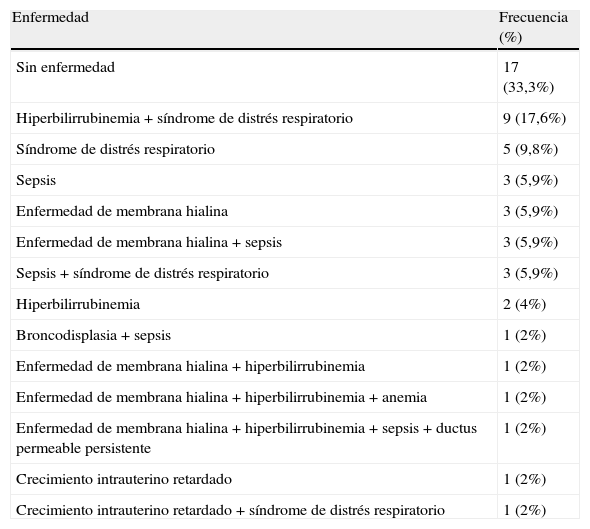Evaluar la eficacia del cuidado canguro (CC) en la reducción del estrés del neonato de 29-34 semanas de edad posmenstrual (EPM).
MétodoEstudio analítico cuasiexperimental pre-post sin grupo control, realizado en la Unidad de Neonatología del Hospital Universitario Gregorio Marañón. Los criterios de inclusión fueron: neonatos de 29-34 EPM, que no padeciesen afección neurológica y/o estuviesen en periodo posquirúrgico, que permaneciesen en incubadora y con madre y/o padre hispanohablante. La muestra consta de 51 pretérminos. Las variables del estudio fueron: clínicas (oxígeno adicional y enfermedad), sociodemográficas (EPM, duración del CC) y variable resultado, estrés del neonato, que comprende dos variables: signos de estrés fisiológicos y respuestas conductuales de estrés. Las variables se recogieron en tres momentos: estrés basal, durante el CC y tras la realización del CC, realizando un análisis de comparación entre la determinación basal de estrés y tras realizar CC.
ResultadosLa tasa de respuesta fue del 100%, sin registrarse ninguna pérdida. Las variables de estrés disminuidas tras CC (diferencias estadísticamente significativas) son: respiración irregular, bostezos, hiperextensión o arqueamiento del tronco, dedos bien abiertos, contracción de los músculos de la cara, irritabilidad, apnea, extensión exagerada y mantenida de los brazos y piernas. La saturación de O2 (SatO2) antes del CC fue del 94,73%±3,05% y tras la intervención, del 95,92%±2,97%. La frecuencia cardíaca (FC) varió de 158,14±17,48 lpm antes del CC a 151,47±4,47 lpm después.
ConclusionesEl CC está relacionado con la disminución de la aparición de variables de estrés del neonato, ayudándole a organizar su sistema motor y fisiológico para alcanzar un estado de tranquilidad.
To assess the efficacy of Kangaroo Care (KC) in decreasing stress in newborns of 29-34 weeks’ post-menstrual age (PMA).
MethodsQuasi-experimental pre-post without control group analytical study conducted in the Gregorio Marañón University Hospital Neonatal Unit. The inclusion criteria were: infants 29 to 34 weeks’ PMA, in an incubator, did not have neurological pathology, were not post-surgical, and with a Spanish-speaking mother and/or father. The sample size was fifty-one premature infants. The study variables selected were: clinical variables (additional oxygen and pathology), socio-demographical variables (PMA, KC duration) and the outcome variable, premature infant stress, which consisted of two variables: the physiological stress signal and the behavioural stress response. The variables were collected at three different times: basal stress, during KC and after KC completion, making a comparison analysis between the basal stress and after KC.
ResultsThe response rate was 100%, without registering any loss. The stress variables that changed after the intervention (statistically significant) were: irregular breathing, trunk arching or hyperextension, very open fingers, contraction of the face muscles, apnea, irritability and exaggerated and sustained extension of arms and legs. O2 saturation was 94.73%±3.05% before KC and 95.92%±2.97% after the intervention. The heart rate (HR) ranged from 158.14±17.48 bpm (beats per minute) before the KC to 151.47±4.47 bpm after it.
ConclusionsKC is related to the decrease in the occurrence of neonatal variables of stress, helping to organize motor and physiological systems to achieve a state of tranquillity.
Artículo
Comprando el artículo el PDF del mismo podrá ser descargado
Precio 19,34 €
Comprar ahora








